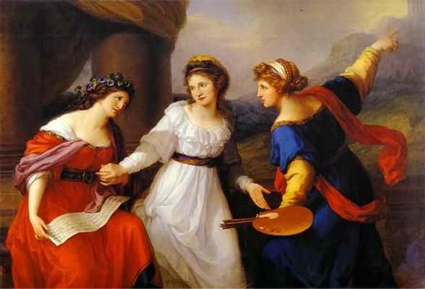Angelica Kauffman came to England from Switzerland in 1764 and spent 15 years here flaunting her own outrageousness: a founder member of the Royal Academy and one of the most celebrated narrative painters of her time, she was a woman in a man's man's man's man's world. Women painters were not that unusual in the late 18th century, but most confined themselves to the supposedly feminine and supposedly minor genres of portraiture and still-life, where it was allowed that female intuitiveness and a taste for the pretty might come in handy. But Kauffman set her sights higher. She aimed to paint History; grand narrative subjects handled with solemn intent. Angelica Kauffman: A Continental Artist in Georgian England, at Brighton Museum and Art Gallery, reveals a woman who was extremely conscious of her own singularity.
Kauffman turned the perceived incongruity of her vocation to advantage by making it one of the prime subjects of her art. She did so most strikingly in her Self-Portrait Hesitating Between the Arts of Music and Painting, a work which now seems subtly proto-feminist in intention. Kauffman pictures herself as a young woman equally gifted at music (she was said to have been a musical prodigy) and painting who would choose the more worthy path of a career in art. The figure of Music is a languorous and slightly soppy muse in a decollete dress, pleadingly clasping the young Kauffman by the hand. To the other side of the artist, the personification of Painting, while still female, is distinctly masculine: she wears blue, the colour of seriousness, and points Kauffman towards the Temple of Glory on a distant hilltop.
The painting is Kauffman's most strident declaration of her determination to pursue what she knows is thought to be an unsuitable career for a woman....

A novel approach
15-12-1992

